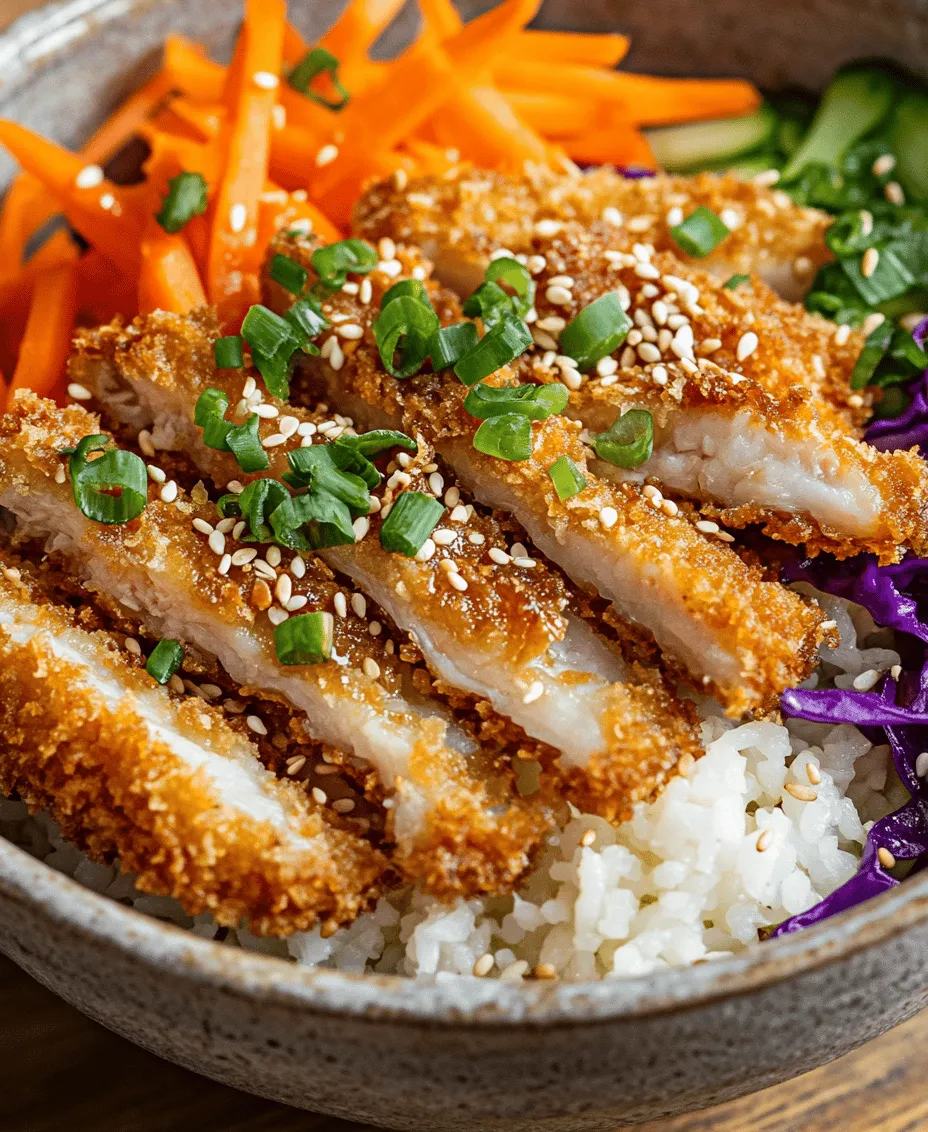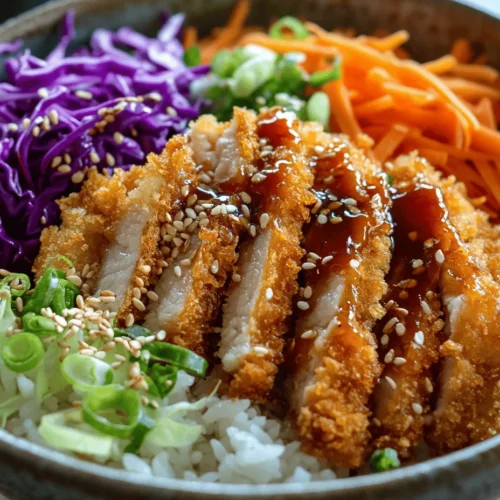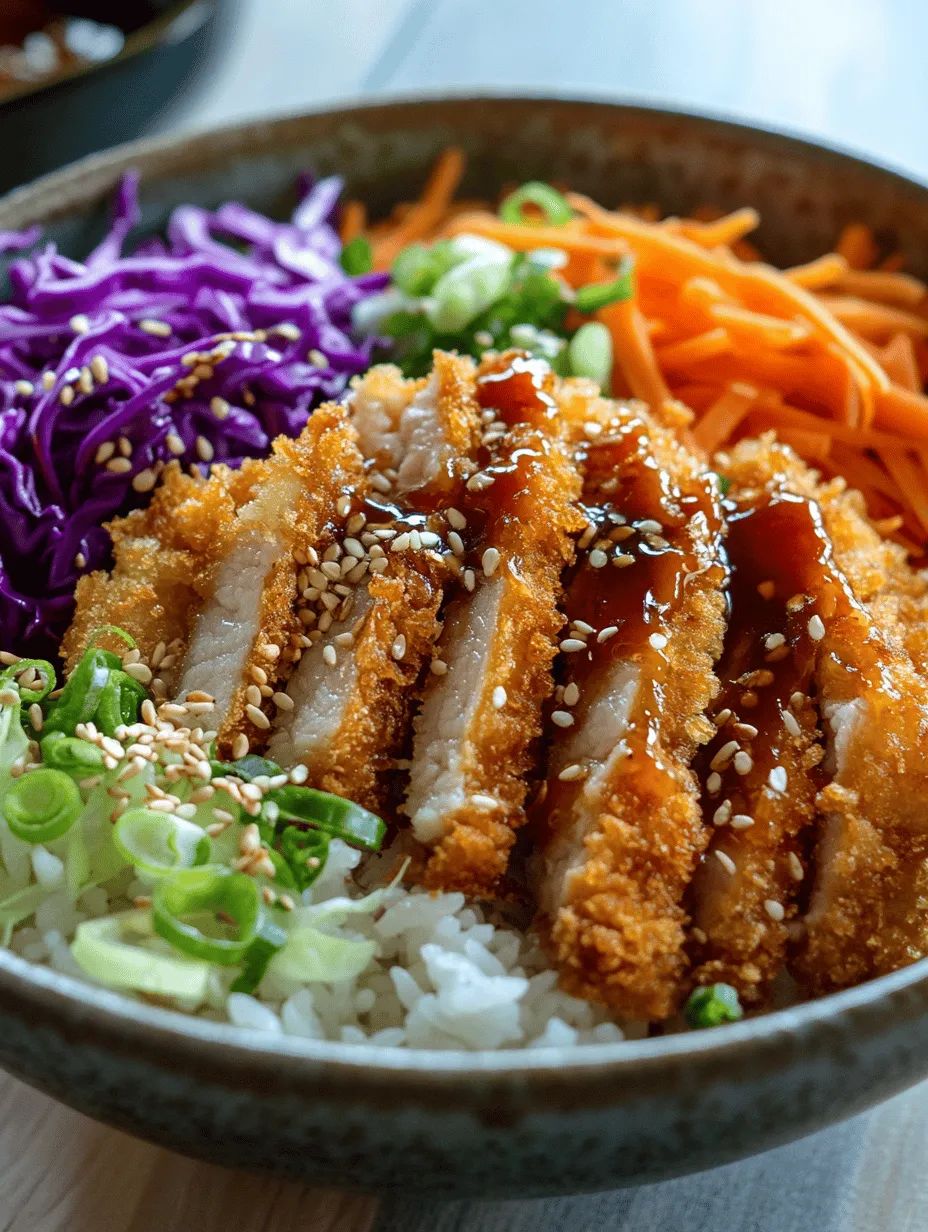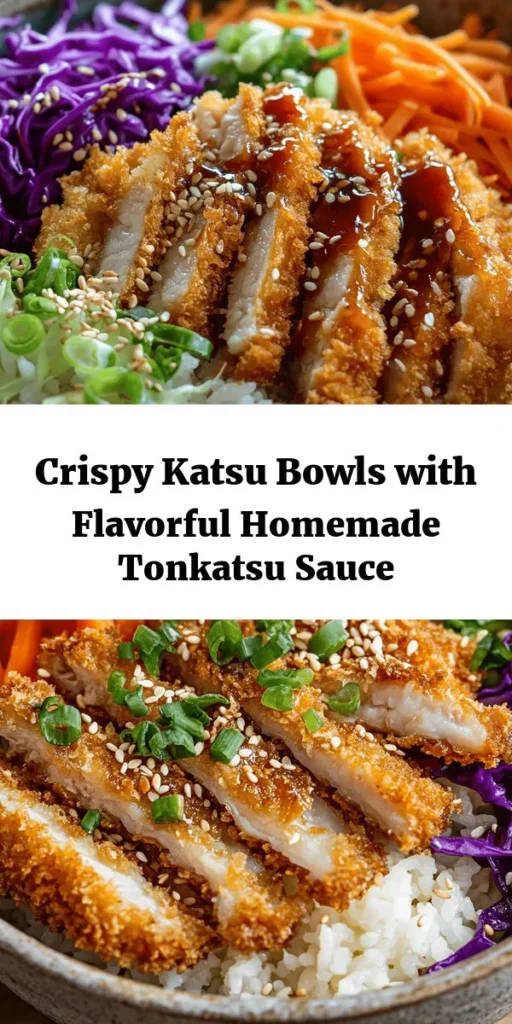Introduction to Crunchy Katsu Bowls
Katsu bowls are a beloved dish within Japanese cuisine, celebrated for their satisfying combination of textures and robust flavors. Originating from the term “katsu,” which means “to cut,” these bowls feature crispy, breaded meat, typically pork, served over a bed of rice, often accompanied by shredded cabbage and a drizzle of rich sauce. The concept of Katsu is not only about nourishment but also about the artistry involved in preparing each component, making it a favorite among both seasoned cooks and culinary novices alike.
The allure of Katsu bowls lies in the harmonious blend of crispy, tender meat and the comforting base of fluffy rice. Each bite provides a satisfying crunch followed by the tender juiciness of the meat, creating a delightful contrast that keeps diners coming back for more. What elevates this dish even further is the homemade Tonkatsu sauce, a unique condiment that infuses the bowl with its sweet, tangy, and savory flavor profile. This sauce is not just an accompaniment; it’s the heart of the dish, enhancing the overall taste experience.
Whether you’re hosting a dinner party or looking to prepare a comforting meal for yourself, Crunchy Katsu Bowls with Homemade Tonkatsu Sauce offer a world of flavor that is both familiar and exciting. This recipe is approachable enough for beginner cooks while still providing a rewarding challenge for those seeking to refine their culinary skills. By making your own Tonkatsu sauce and mastering the techniques for perfecting the Katsu, you’ll not only impress your guests but also gain a deeper appreciation for the artistry of Japanese cooking.
Understanding Tonkatsu Sauce
At the core of every Katsu bowl is Tonkatsu sauce, a rich and versatile condiment that elevates the dish to new heights. This sauce, often referred to as the “secret weapon” of Katsu, boasts a complex flavor profile made up of sweet, tangy, and savory notes. To truly appreciate the beauty of Tonkatsu sauce, it’s essential to understand its primary ingredients and the role each plays in creating that iconic taste.
Explanation of Ingredients
Tonkatsu sauce typically consists of a blend of several key ingredients, including ketchup, Worcestershire sauce, soy sauce, mirin, and sugar. Each of these components contributes to the sauce’s unique flavor:
– Ketchup: Provides sweetness and a slight acidity, forming the base of the sauce. It also contributes to the rich color that enhances the visual appeal of the dish.
– Worcestershire Sauce: Adds depth with its complex flavor profile, which includes tanginess and umami notes. This ingredient often contains ingredients like vinegar, molasses, and various spices, enriching the overall taste of the sauce.
– Soy Sauce: Introduces a salty and savory element, balancing out the sweetness from the ketchup and sugar.
– Mirin: A Japanese rice wine that imparts a subtle sweetness and depth, adding to the complex flavor profile that makes Tonkatsu sauce so unique.
– Sugar: Enhances the sweetness and helps to create a glossy texture, ensuring that the sauce clings beautifully to the crispy Katsu.
Importance of Balance Between Sweet, Tangy, and Savory Flavors
The beauty of Tonkatsu sauce lies in its balance. The interplay of sweet, tangy, and savory flavors creates a well-rounded condiment that complements the crunchy texture of the Katsu perfectly. This balance is crucial in Japanese cuisine, where flavors are often layered to create depth and complexity in each dish. When paired with the crispy Katsu, each bite becomes a delightful experience, as the crunchy coating meets the rich, flavorful sauce, enhancing the overall enjoyment of the dish.
The Cultural Context
Tonkatsu sauce has its roots deeply embedded in Japanese culinary tradition. It was developed in the late 19th century, around the same time that Western cuisine began to influence Japanese cooking. The sauce was initially inspired by British-style sauces, but over time, it evolved into a uniquely Japanese condiment that perfectly complements the fried meat dish known as Katsu.
Tonkatsu sauce is not limited to just Katsu bowls; its versatility allows it to be used in various dishes, from drizzling over fried vegetables to serving as a dipping sauce for skewered meats. The significance of Tonkatsu sauce extends beyond mere flavor; it symbolizes the fusion of cultures and the evolution of traditional Japanese cooking, making it a staple in many households throughout Japan and beyond.
The Art of Preparing Tonkatsu
Creating the perfect Tonkatsu is an art form that involves selecting the right cut of meat, mastering breading techniques, and frying to perfection. Each step is essential in achieving the coveted crunchy texture that defines this dish.
Selecting the Right Cut of Meat
The foundation of a great Tonkatsu lies in choosing the right cut of meat. Traditionally, pork loin or pork tenderloin is used, but you can also explore other options like chicken or even eggplant for a vegetarian version. Here are some tips for selecting quality meat:
– Pork Loin: Look for a cut that has a good balance of meat and fat. A pork loin chop with some marbling will provide tenderness and flavor.
– Pork Tenderloin: This cut is leaner and can be used for a healthier version of Tonkatsu, but it may require careful frying to avoid dryness.
– Quality: Always choose high-quality, fresh meat from a reputable butcher or grocery store. Look for meats that are bright in color with a firm texture.
Breading Techniques
Breading is a crucial step that contributes to the signature crunch of Tonkatsu. The following steps will guide you through the breading process:
1. Prepare the Meat: Start by trimming any excess fat from the meat. If using pork loin, you may want to pound it lightly with a meat mallet to ensure even cooking and tenderness.
2. Dredging Stations: Set up a dredging station with three shallow dishes: one with all-purpose flour, one with beaten eggs, and the last with panko breadcrumbs. This three-step process ensures an even coating.
3. Coat the Meat: First, dip the meat into the flour, shaking off any excess. Then, transfer it to the beaten eggs, allowing the egg to coat the meat fully. Finally, press the meat into the panko breadcrumbs, ensuring an even layer is applied. The use of panko breadcrumbs is crucial as they provide the desired crunch due to their coarser texture compared to traditional breadcrumbs.
Frying Tips for Perfect Tonkatsu
Frying is where the magic happens, and following the right techniques will help you achieve that crispy exterior without the greasiness. Here are some essential frying tips:
– Ideal Oil Temperature: Heat the oil in a deep skillet or fryer to about 350°F (175°C). You can test the temperature by adding a small piece of bread; if it sizzles and turns golden brown within a few seconds, the oil is ready.
– Frying in Batches: Avoid overcrowding the pan, as this can lower the oil temperature and result in soggy Katsu. Fry in batches, ensuring each piece has enough space to cook evenly.
– Drain Excess Oil: Once the Tonkatsu is golden brown and cooked through (about 3-5 minutes per side, depending on thickness), remove it from the oil and place it on a wire rack or paper towels to drain excess oil. This step is vital for maintaining that delightful crunch.
– Safety Tips: When frying at home, always practice safety measures. Use a deep-fry thermometer to monitor oil temperature, and keep a close eye to prevent any spills or splatters. It’s also wise to keep a lid nearby in case of an emergency.
By mastering these steps, you will not only create a deliciously crunchy Tonkatsu but also gain confidence in your cooking abilities. The combination of selecting the right meat, perfecting your breading technique, and frying correctly will ensure your Crunchy Katsu Bowls are a hit every time.
As we delve deeper into this recipe, the next steps will guide you through assembling your Katsu bowls, along with serving suggestions and variations to explore. Stay tuned for a culinary journey that brings the flavors of Japan straight to your kitchen.

Building the Perfect Katsu Bowl
Assembling your Crunchy Katsu Bowl is not only about taste; it’s also about presentation. A well-constructed bowl can turn a simple meal into an impressive feast. Let’s dive into the components that make a perfect Katsu Bowl, ensuring each element complements the others harmoniously.
Choosing the Right Rice
The foundation of any great Katsu Bowl is the rice. When it comes to selecting the right type, you have two popular options: sushi rice and short-grain rice.
Sushi Rice vs. Short-Grain Rice
Sushi rice is a seasoned rice that is sticky and slightly sweet, making it a great base for various dishes, including Katsu Bowls. On the other hand, short-grain rice, while not seasoned, has a similar stickiness and texture that holds together well under the weight of toppings.
Cooking Tips for Achieving the Right Texture
To cook your rice to perfection, start by rinsing it under cold water until the water runs clear. This removes excess starch, preventing it from becoming too sticky. Use a rice cooker or a pot with a tight-fitting lid to steam the rice. The general ratio is 1 cup of rice to 1.2 cups of water. Allow the rice to soak for 30 minutes before cooking, as this helps achieve a tender texture. Once cooked, let it sit covered for an additional 10 minutes to ensure even moisture distribution.
Vegetable Components
No Katsu Bowl is complete without a vibrant array of vegetables. Traditionally, Katsu Bowls include shredded cabbage and julienned carrots, but you can also add your favorites for added color and nutrition.
Overview of Traditional Vegetables Used in Katsu Bowls
– Cabbage: Shredded cabbage provides a crunchy texture and a refreshing contrast to the rich flavor of the Katsu. It’s also a great source of dietary fiber and vitamins C and K.
– Carrots: Thinly sliced or julienned carrots add a touch of sweetness and a beautiful orange hue to the bowl. They are packed with beta-carotene, which is essential for eye health.
Health Benefits of Cabbage and Carrots
Both cabbage and carrots are low in calories and high in nutrients, making them excellent choices for those looking to maintain a balanced diet. Cabbage is known for its anti-inflammatory properties, while carrots contribute to better vision and skin health. Together, they create a nutritious foundation for your Katsu Bowl.
Garnishing Techniques
Garnishing is an essential final touch that elevates your Katsu Bowl, making it visually appealing and enhancing the overall flavor profile.
Suggestions for Garnishing with Sesame Seeds
To add a nutty flavor and a bit of crunch, sprinkle some toasted sesame seeds over the top of your Katsu Bowl. Not only do they provide a delightful texture, but they also contribute healthy fats and protein.
The Role of Pickled Ginger
Incorporating pickled ginger not only adds a pop of color but also introduces a tangy contrast that balances the richness of the Katsu. Serve it on the side or atop the bowl to enhance the dish’s flavor and offer a palate cleanser between bites.
How Garnishes Enhance Presentation and Flavor
Garnishes are more than just decoration; they play a crucial role in the dining experience. A well-garnished Katsu Bowl will entice the eyes and excite the palate, making the meal more enjoyable. The combination of colors, textures, and flavors creates a visually stunning and delicious dish that you and your guests will love.
Nutritional Overview of Katsu Bowls
Understanding the nutritional profile of your Crunchy Katsu Bowl is essential for maintaining a balanced diet while indulging in this delicious meal.
Caloric Breakdown
A serving of Katsu Bowl can range from 600 to 800 calories, depending on the portion size and the ingredients used. The calorie content primarily comes from the fried Katsu, rice, and any additional sauces.
How It Fits into a Balanced Diet
While Katsu Bowls are certainly indulgent, they can fit into a balanced diet when consumed in moderation. Pair your Katsu Bowl with a side of fresh vegetables or a light salad to balance the meal with fiber and nutrients.
Healthier Alternatives
If you’re looking to lighten up your Katsu Bowl without sacrificing flavor, consider these alternatives:
– Baking Instead of Frying: Instead of deep-frying your Katsu, try baking it in the oven. This method significantly reduces the amount of oil used, making your dish lighter while still achieving a crispy exterior.
– Using Leaner Cuts of Meat: Opt for chicken breast or pork loin instead of fattier cuts. These options are lower in calories and saturated fat while still providing the protein you need.
Importance of Portion Control
Portion control plays a vital role in enjoying your Crunchy Katsu Bowl while keeping your calories in check. Consider using smaller bowls to serve your meal, or be mindful of how much rice and Katsu you place in your bowl. Aim for a balanced plate that includes a mix of protein, carbs, and vegetables, ensuring you enjoy the dish without overindulging.
Conclusion: The Joy of Homemade Crunchy Katsu Bowls
Creating your own Crunchy Katsu Bowls is a rewarding experience that brings the delightful flavors of Japanese cuisine into your home. The satisfaction of crafting each component—from the crispy Katsu to the perfectly cooked rice and vibrant vegetables—offers a sense of accomplishment that is hard to match.
Beyond the cooking process, Katsu Bowls are perfect for sharing with friends and family. Whether you’re hosting a casual dinner or a special gathering, these bowls can be customized to suit everyone’s tastes, making them a versatile choice for any occasion.
In summary, the joy of making homemade Crunchy Katsu Bowls lies not only in the delicious flavors and textures but also in the connections forged over a shared meal. So gather your ingredients, roll up your sleeves, and embark on this culinary adventure. Your taste buds—and your loved ones—will thank you.



